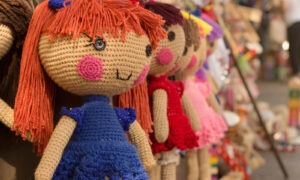In many parts of the world, black is worn to funerals. It is often perceived as the color of death and mourning. For some, the dark symbolism of the color black can become off-putting. When this aversion becomes a phobia, it is called melanophobia.
This fear can surface for many reasons. It can be the result of memories and emotions that resurface when the color black is present. It can also be a reflection of the way our culture uses black to represent dark elements of human nature and existence.
Since white is often perceived as the color of purity, the color black holds the opposite position. Black may be affiliated with doom in the eyes of some phobic persons.
While it is clearly irrational to fear a color in and of itself, there are myriad examples to support the idea that the color black is malevolent or unlucky.
The Color Black In History, Religion, and Popular Culture
The Black Death
In the year 1347 A.D., the bubonic plague spread like wildfire throughout Europe. This disease devastated the cities and villages of the continent, and decimated the population. The pandemic was more commonly known as The Black Death, or The Black Plague.
Citizens came to dread the black spots that would appear on the arms and legs of the infected. Over a third of Europe’s population died due to the contagion.
At the time of the outbreak, people had little understanding of the ways in which such diseases were transmitted. They came to believe that The Black Death was a punishment, meted out by an angry God. The association between The Black Death and sin was a powerful source of terror in the 14th century.
In time, it became clear that Black Rats and their fleas were one possible carrier of the Black Death.
Witches and Satanism
Angels are often depicted in flowing robes of pristine white. For this reason, white is embraced as a color of purity and chasitity. The white wedding gowns of brides are meant to be a symbol of virginity and virtue.
Conversely, black has been adopted by the occult as its most meaningful color. For members of the occult, black serves as an act of defiance against Christian values. Witches are often depicted in flowing cloaks and pointed hats of pitch black. Satanic rituals are often performed in dark rooms where black candles flicker in the gloom.
Halloween costumes often borrow elements of the occult, and they are frequently black. Halloween itself it viewed with a jaundiced eye by devout Christians, because it takes its cue from witches and other ancient occult rituals. Halloween was initially a Pagan festival of the Dead.
Today, black has become the color of choice for certain subcultures in modern society. Goths are often clad in head-to-toe black, but this does not mean they are Satanists.
Initially, Goths were a part of the Punk scene., sharing the same interests in music, rebellion and the anti-establishment. Both Punks and Goths often choose to wear black clothing. Goths are also known to powder their faces a ghostly white, and apply a lot of smoky, black eye makeup. Goths enjoy the dark, melancholy elements of human nature and culture. They embrace a vampire aesthetic, as well as the music of Bauhaus and Sisters of Mercy.
Today, some people feel nervous around Goths and Punks, because they seem menacing or dangerous. This heavy use of black in attire and makeup may trigger melanophobia in people who are threatened by their appearance.
Symptoms Of Fear Of The Color Black
People who fear the color black will experience the symptoms of a panic attack when they are exposed to the color. They will feel nausea, dizziness, terror, racing heartbeart, and extreme anxiety when they are forced to be around the color. Melanophobics will take pains to keep their own home environment and wardrobe free of the dark shade.
Treatment for Melanophobia
As with most phobias, sufferers will benefit from a course of therapy that allows them to come to terms with their fears. Getting at the root of why they fear black will allow some release of tension.
Hypnotherapy and cognitive therapy have both been used with varying degrees of success when treating phobias.




















